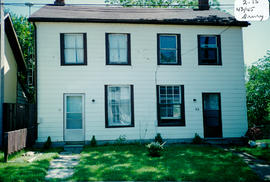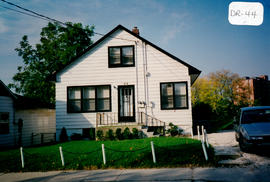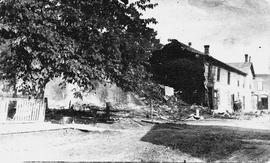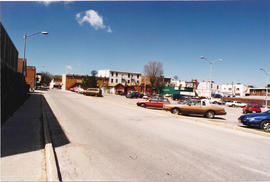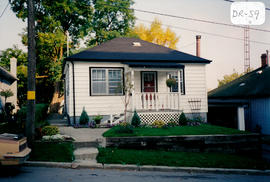The house located at 39 Drury St. (at the southeast corner of Drury and Thomas Streets) was built pre-1900 in the Ontario Vernacular Cottage style. Bob (“Red”) Armstrong, a bachelor, once lived here. Jim Webb eventually bought the property and rented the structure to Victor Hunter (a carpenter) and his family. Frank Park (a handyman) kept his horse in the small barn on the property. Charles Hounsome (a railway section man) also lived here at one time. Lloyd Houston (a butcher) and his wife Jean lived here after the wars.
The one-storey, three-bay cottage has a shallow-pitched, gable roof, a symmetrical façade, and a rectangular plan with a centre hall. A box hall was typical for this style. The simple entrance has a single door set into a rectangular opening. It opens directly into the house from grade level and there is no porch (or weather protection) to shelter the entrance. The windows have low floor to ceiling heights. There are double-hung, 2/2 windows on either side of the entrance that appear to be original. They are set into simple, rectangular openings with plain, wood frames and sills. Wood frame construction is covered with vinyl siding. The original cladding was wood. The house has a parged, stone foundation. There is a single, brick masonry chimney at the centre of house. According to the 2000 inventory, this simple cottage probably had few decorative details originally. It also notes that the concrete block chimney on the exterior south wall is a later addition. (1, 2, 3)
Drury Street
11 Descripción archivística resultados para Drury Street
The mid-block building located at 43 and 45 Drury St. was built in the Neoclassical Duplex style in the 1860-1880’s. Leonard Saint bought the building in 1909 from Mrs. Garrett (mother of E. Garrett who owned the Bradford Witness newspaper). Len was in the building trade and he was a brick layer, a plasterer, and a cement worker in Bradford. In 1911, he moved the building twenty feet back from the street, raised it, and put in a cellar as well as a parged, stone foundation. He also added two rear kitchens. There was a garage on the back lot facing Elizabeth Street. The south side of the house was rented to various people. The building stayed in the Saint family until the 1980’s.
The two-storey, four-bay, semi-detached house has a simple form with separated, side-hall entrances in the formal, symmetrical façade. It has a shallow-pitched, gable roof and gable end chimneys. The upper portion of the original, wood-panelled doors is glazed and has multiple lights at the top. This is reminiscent of the transom found in a more ‘’upscale” home of this period. There are large window openings with high floor to ceiling heights. Large, 6/6 wood sash windows at the ground floor are original. The upper-floor window openings align with the ground-floor openings and the windows have plain wood frames and sills. Wood frame construction is covered with vinyl siding. The original cladding was stucco on wood lath. According to the 2000 inventory, this building is a modest example of workers’ housing. It also notes that it is in good condition with some original details remaining. (1, 2, 3)
The one-storey house once located on the west side at 44 Drury St. had stucco cladding originally. Many years ago it was the home of Fred McKay, his wife, and son (Bruce). Fred was a retired farmer. He had noted gardens (asparagus, strawberries, raspberries) on a number of lots around town. Fred worked for Thompson Fisher in the old skating rink. He also ran the pool room and sold gramophones over the Campbell’s drugstore on Holland Street. Chris Wren and his family lived here years later. Chris was a store merchant (from Mabel) and a painter and paper hanger. The house was demolished (in the 1990’s?) to make an exit and sewer connection from Joe Magani’s grocery store to Drury Street. (1, 2)
Sin títuloThe house located at 55 Drury St. was considered to be new when this photo was taken in 1995. (1)
Sin títuloThe photograph depicts the ruins of a fire on Drury Street in 1910. B.B. Collings is featured in it with the fire department.
Sin títuloView of Mary Street - Drury Street parking lot, looking north
Sin títuloThe house located at 59 Drury St. was considered to be new when this photo was taken in 1995. Bill Aitkens (Aitken?) had a horse stable on the property many years ago. (1, 2)
Sin títuloAlthough currently being used as a parking lot, there was originally at least one house on this property located at the corner of Drury and Thomas Streets. George, Mell (Mel?), and Davey John had a one-storey, frame stucco house here. Margaret "Maggie" MacDonald was the housekeeper and cook for the family. George was a handyman. He worked for Jack Spencer and Ben Collings fleshing and marsh haying. Mell (Mel?) was a day worker, gardener, handyman, and wood cutter. Davey John was a machinist and bearing lead (?) specialist. He was also a noted storyteller. Behind the house was a woodshed, back porch, chicken run, and chicken house. There was a garden next to the fence of the Queen’s Hotel. There were sheds from the hotel along the west side of the property. Pigs were fed with slops from the hotel. There was a two-storey barn with a loft, horse stables, and car garage facing Elizabeth Street. The house later became the home of Frank Cook, son Norman, and mother (Olive Whiteside). He was a labourer, small truck driver (picking up garbage), and a gravel (grave?) digger. Len and Aida Gardner and family moved into the house years later. They then moved into an apartment when the house was demolished. (1, 2)
Sin títuloThe article accompanying this photograph gives a quick history of B.B. "Ben" Collings' life and business. By this point, his furniture and undertaking business was only four years old (starting in 1902) and the storefront is shown in the photograph, located on the south-west corner of Holland and Drury Streets. The post office is opposite. It was said in the showroom, there would "be found some of the nicest furniture one could wish to place in his home."
Starting in 1897, Ben spent four years studying the mattress making trade in Toronto.
The mid-block building once located at 49 Drury St. was built in the neoclassical style around 1880. James Currie (a retired farmer, businessman, carpenter and noted gardener) and his wife lived here many years ago. Gilbert Lukes, his wife, and some of his family also lived here at one time.
The two-storey, rectangular building had a symmetrical façade, a centre hall plan, and a medium-pitched, gable roof. It had large window openings with high floor to ceiling heights. The large, 2/2 double-hung, wood windows had wood lug sills. Aluminum storm windows were modern additions. The house had symmetrically-placed chimneys at both ends of the roof. The metal roof had minimal eaves projection. There were decorative brick dentils at the cornices and stepped brick corbels at the projecting, end gable walls (firewall-type construction). The building had solid, brick construction. At one time the house had a woodshed (with a toilet inside), a chicken run, and a chicken house attached to the barn (with a horse and cow stable), car garage (and loft above) on the laneway. The house was demolished in June, 1997. (1, 2, 3)

